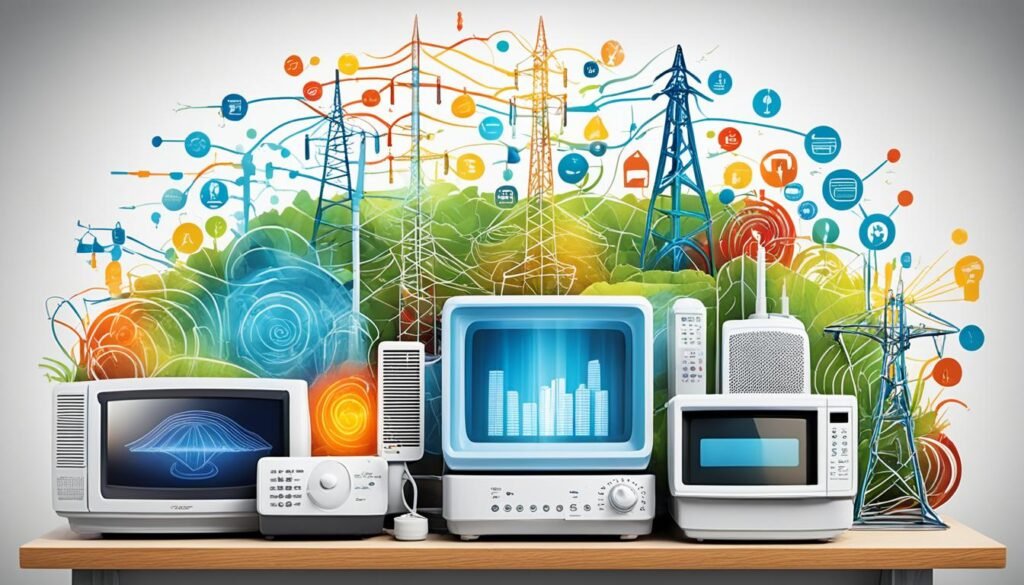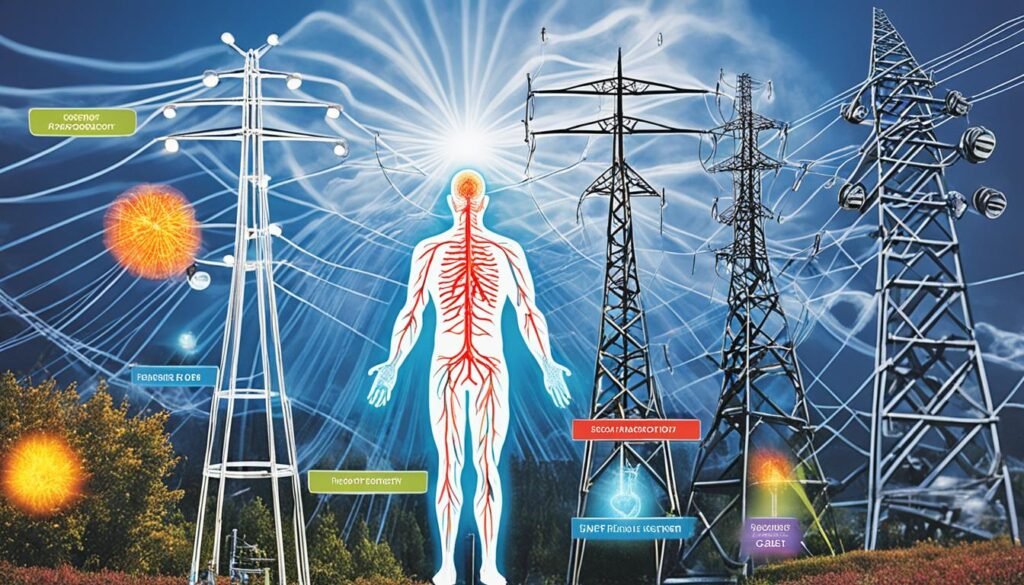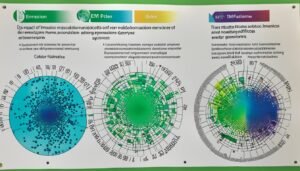Disclosure: This Post Contains Affiliate Links; We earn a commission on purchases.
Electric and magnetic fields (EMFs) are a part of our everyday lives, originating from various electronic devices and radiation sources. These electromagnetic fields can have an impact on our health and well-being. It is essential to understand the sources of EMFs to minimize exposure and promote better health.
EMFs can be categorized into high-frequency and low to mid-frequency fields. While high-frequency EMFs like x-rays and gamma rays are classified as ionizing radiation, low to mid-frequency EMFs come from sources such as power lines, appliances, and wireless devices, and they fall under non-ionizing radiation. These non-ionizing EMFs can be found in common household items like microwaves, cordless phones, cell phones, Wi-Fi routers, and computers.
By familiarizing ourselves with these everyday sources of EMFs, we can make informed decisions to reduce our exposure. Practicing EMF safety is an important step towards maintaining a healthier environment for ourselves and our loved ones.
Key Takeaways:
- Electric and magnetic fields (EMFs) are present in our everyday lives.
- EMFs are categorized into high-frequency and low to mid-frequency fields.
- Low to mid-frequency EMFs come from common electronic devices and appliances.
- Understanding EMF sources is crucial for minimizing exposure and promoting better health.
- Follow EMF safety guidelines to reduce exposure and protect yourself and your family.
Electric and Magnetic Fields: What You Need to Know
Electric and magnetic fields (EMFs) play a crucial role in our modern world, powering our homes, workplaces, and the electronic devices we use daily. In this section, we’ll explore the fundamentals of EMFs, the different types of radiation they encompass, and their potential effects on our health.
Understanding the electromagnetic spectrum
EMFs are classified into two categories: ionizing radiation and non-ionizing radiation. Ionizing radiation, such as x-rays and gamma rays, carries enough energy to remove tightly bound electrons from atoms and alter the structure of DNA. On the other hand, non-ionizing radiation, including low- to mid-frequency EMFs, lacks the energy necessary to cause direct damage to cells or DNA.
The electromagnetic spectrum encompasses a wide range of radiation, from extremely long wavelengths (such as radio waves) to extremely short wavelengths (such as gamma rays). EMFs fall within this spectrum, with ionizing radiation at the higher end and non-ionizing radiation at the lower end.
The potential health effects of EMF exposure have been a topic of extensive research and debate. While ionizing radiation is known to have harmful effects on DNA and cells, the effects of non-ionizing EMFs on human health are less clear. The scientific consensus thus far suggests limited evidence of a direct causal relationship between non-ionizing EMFs and adverse health effects.
Our guide to EMFs
In the upcoming sections, we’ll delve deeper into the common sources of non-ionizing EMFs, assess the health effects of EMF exposure, and explore measures for minimizing exposure and promoting EMF awareness. By understanding the different aspects of EMFs, you’ll be better equipped to make informed decisions about your health in our increasingly connected world.
Common Sources of Non-Ionizing EMFs
Non-ionizing EMFs, which are generated by both natural and human-made sources, can be found in our everyday lives. Natural sources of non-ionizing EMFs include the earth’s magnetic field, while human-made sources encompass ELF-EMFs and radiofrequency radiation.
ELF-EMFs, or extremely low-frequency electromagnetic fields, are commonly emitted by power lines, electrical wiring, and household appliances. Some examples of household appliances that generate ELF-EMFs include hair dryers and electric blankets. These appliances produce electric and magnetic fields that contribute to the overall electromagnetic field exposure.
“ELF-EMFs emitted by everyday household appliances and power lines can contribute to an individual’s overall exposure to non-ionizing EMFs.”
Radiofrequency radiation, another form of non-ionizing EMFs, is emitted by various wireless devices and communication systems. Devices such as cell phones, tablets, and Wi-Fi routers emit radiofrequency radiation. Additionally, radio and television signals are sources of radiofrequency radiation. Other common sources include radar systems, satellite stations, microwave ovens, cordless phones, and cell phone base stations.
It is essential to be aware of these common sources and their potential contribution to non-ionizing EMF exposure. Understanding the sources of non-ionizing EMFs can aid individuals in evaluating and managing their exposure levels in everyday life.

Common Sources of Non-Ionizing EMFs:
| Source | Type of EMFs |
|---|---|
| Power lines | ELF-EMFs |
| Electrical wiring | ELF-EMFs |
| Household appliances (hair dryers, electric blankets, etc.) | ELF-EMFs |
| Cell phones | Radiofrequency radiation |
| Tablets | Radiofrequency radiation |
| Wi-Fi routers | Radiofrequency radiation |
| Radio and TV signals | Radiofrequency radiation |
| Radar systems | Radiofrequency radiation |
| Satellite stations | Radiofrequency radiation |
| Microwave ovens | Radiofrequency radiation |
| Cordless phones | Radiofrequency radiation |
| Cell phone base stations | Radiofrequency radiation |
Assessing the Health Effects of EMF Exposure
The impact of EMF exposure on human health, especially non-ionizing radiation, has been extensively researched. While some studies have indicated a potential association between EMF exposure and adverse health effects such as childhood leukemia and brain cancer, the overall scientific consensus suggests limited evidence to establish a direct causal relationship.
“The extensive research conducted on the health effects of EMF exposure has provided valuable insights, but there is still much we need to understand.”
The International Agency for Research on Cancer (IARC) has classified radiofrequency EMFs, emitted by cell phones and wireless devices, as a possible human carcinogen. However, additional research is required to comprehensively comprehend the long-term health implications of EMF exposure.
It is worth noting that the level of EMF exposure decreases with increasing distance from the source. Regulatory agencies have established guidelines to limit public exposure to EMFs from power lines and other sources, ensuring that the general population is protected within acceptable limits.

Conclusion
Everyday EMF sources are an integral part of modern life, and it’s essential to be mindful of their potential impact on our health. While the research on the health effects of EMF exposure is ongoing, there are practical steps individuals can take to minimize their exposure and promote better well-being.
To protect yourself from EMFs, consider using wired connections instead of relying solely on wireless devices. This reduces your direct exposure to electromagnetic radiation. Additionally, it’s advisable to keep your cell phone away from your body when not in use, as this can help minimize your exposure to radiofrequency EMFs. Creating distance between yourself and EMF-emitting sources, such as power lines and electronic devices, is another effective way to reduce your overall exposure.
Increasing awareness of EMF sources is crucial in making informed decisions about our daily habits, and taking proactive measures for protection can contribute to a healthier environment for ourselves and our families. By adopting these simple EMF safety tips, we can maintain a balance between the convenience of modern technology and our well-being.
Source Links
- https://www.cancer.gov/about-cancer/causes-prevention/risk/radiation/electromagnetic-fields-fact-sheet
- https://www.niehs.nih.gov/health/topics/agents/emf
- https://www.healthline.com/health/emf

Subscribe to Our Newsletter










